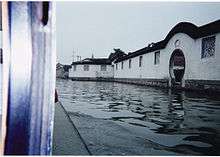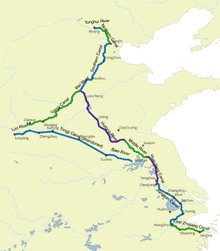Along the Grand Canal
The Grand Canal (大运河) is in China, an engineering work comparable to the Great Wall. Like the Wall, it is very old and parts of it were built by different dynasties. Unlike the Wall, it is still heavily used and actively maintained today.

- This article is an itinerary.
The Canal runs roughly North-South for 1800 kilometers (1100-odd miles) from Beijing in the north to Hangzhou (south of Shanghai) in the south. On the way it crosses two of China's great rivers, the Yangtze and the Yellow River, and passes through many cities. The oldest parts of the canal date to the 5th century BCE, and the various sections were combined during the Sui Dynasty (581–618 AD).
The Canal is now on the UNESCO World Heritage List with this listing.
While the Grand Canal was for centuries a major transport artery, there are now no scheduled intercity passenger boat services on the canal at all. The Hangzhou-Suzhou passenger line was the last major service to go, in 2006. A small stub line remains, but you can only take it along the portion of the Canal that is within Hangzhou city limits.
The route

The main canal runs:
- Ningbo, where it enters the East China Sea
- Shaoxing
- Hangzhou
- Jiaxing
- Suzhou
- Wuxi
- Xuzhou
- Yangzhou, where it crosses the Yangtze
- Huai'an, where another canal branches off to Kaifeng and Luoyang
- Jining
- Dezhou
- Tianjin
- Beijing
In the Suzhou/Wuxi area, Lake Tai is connected to the canal.